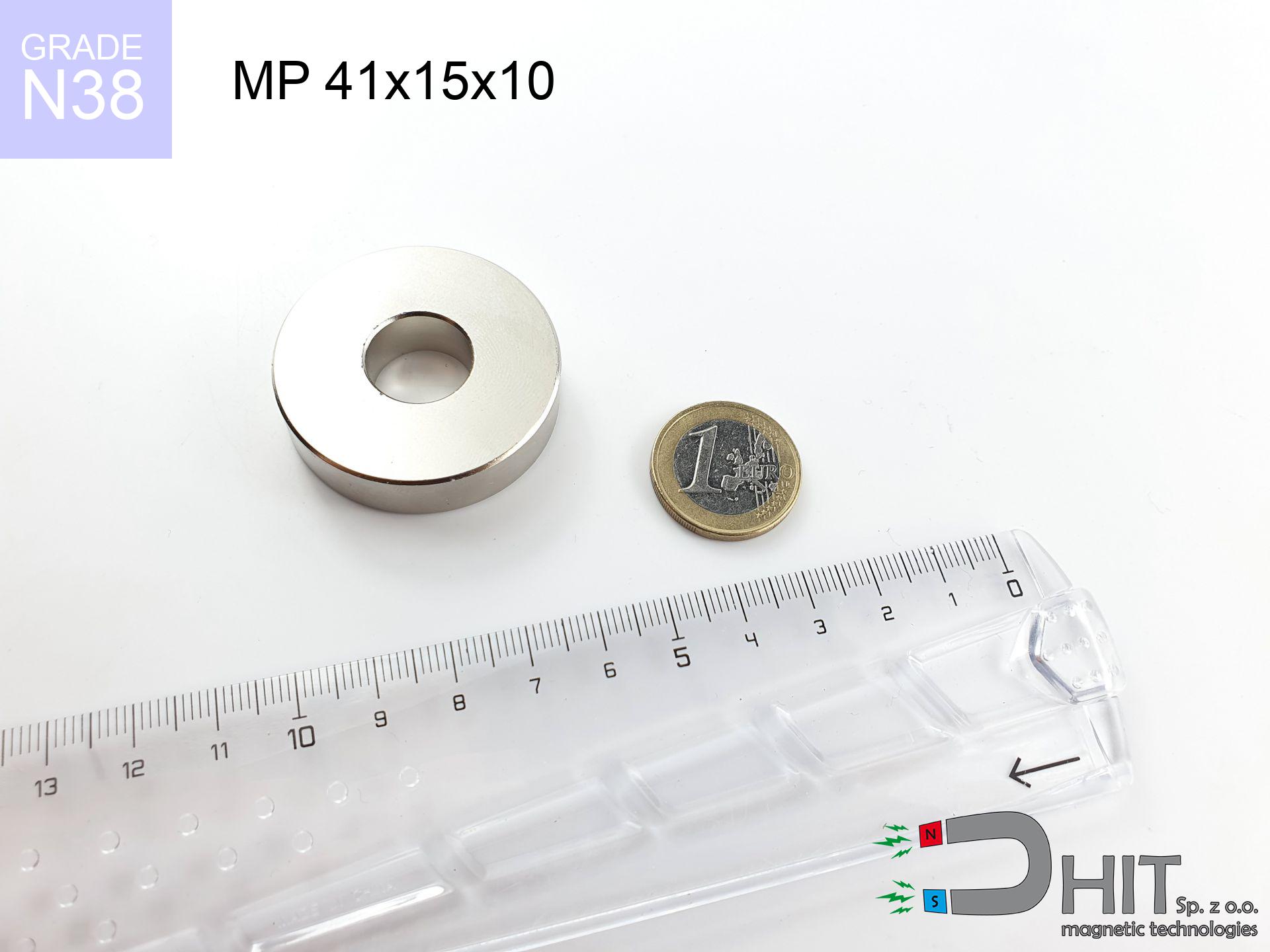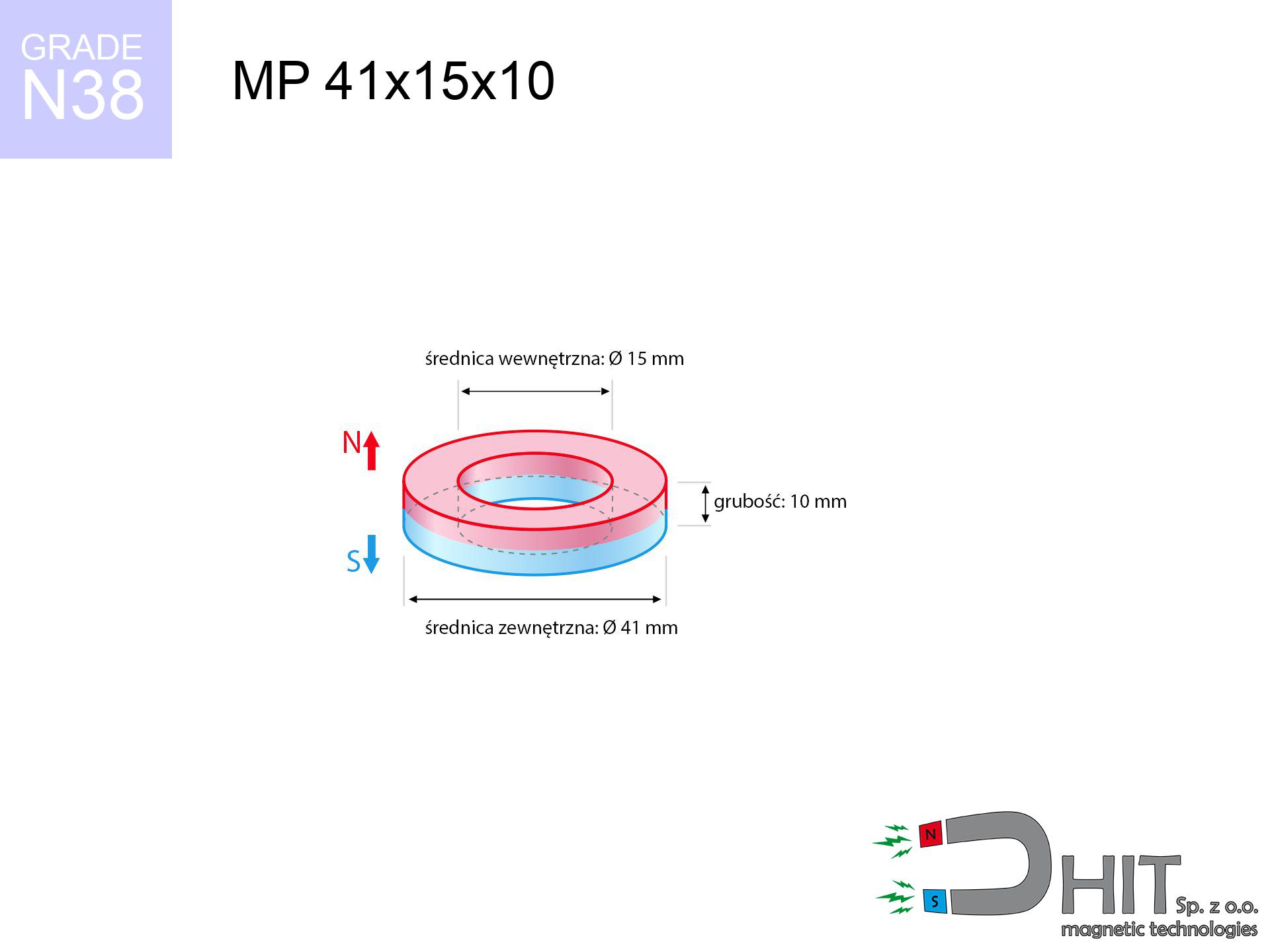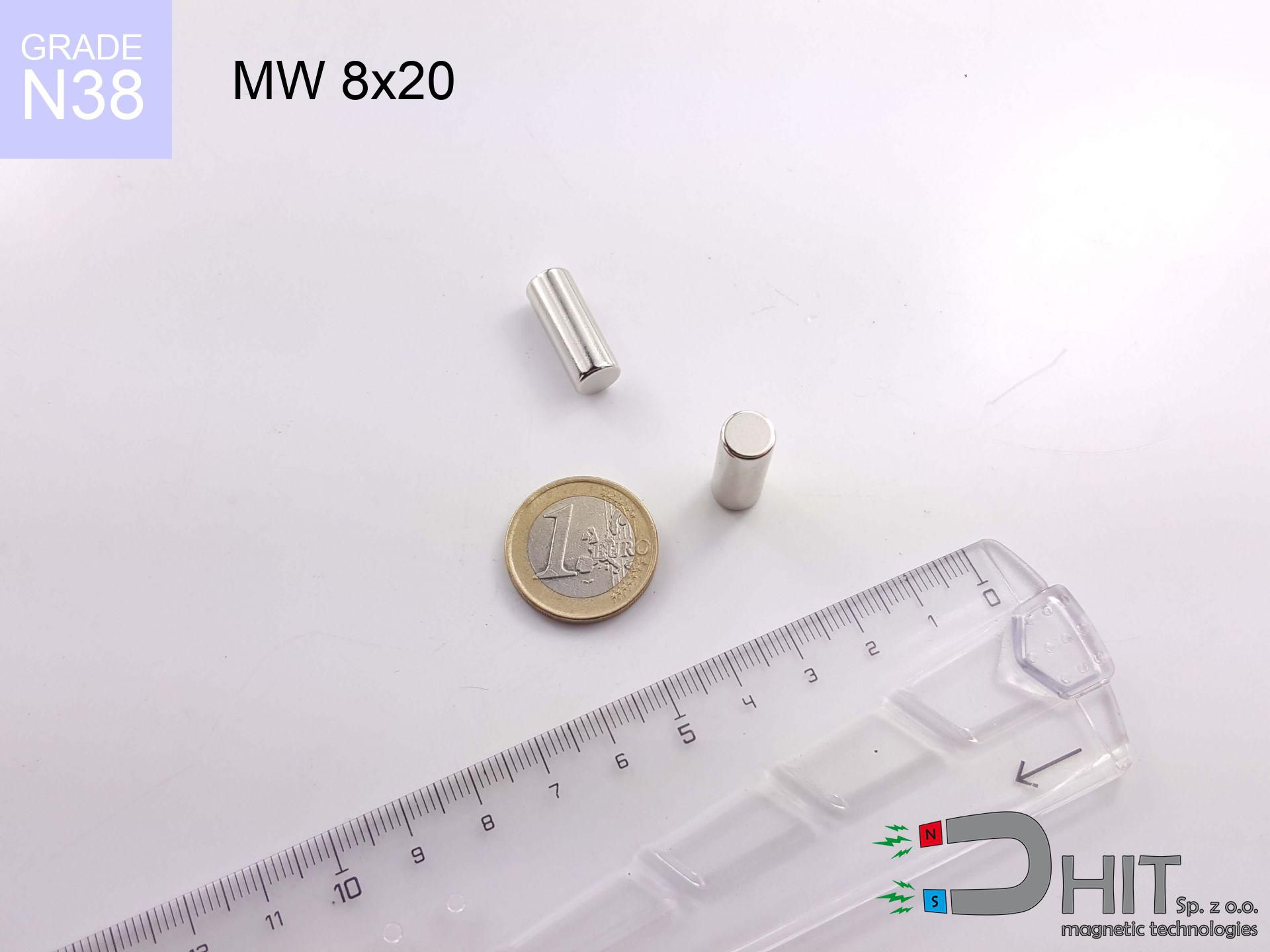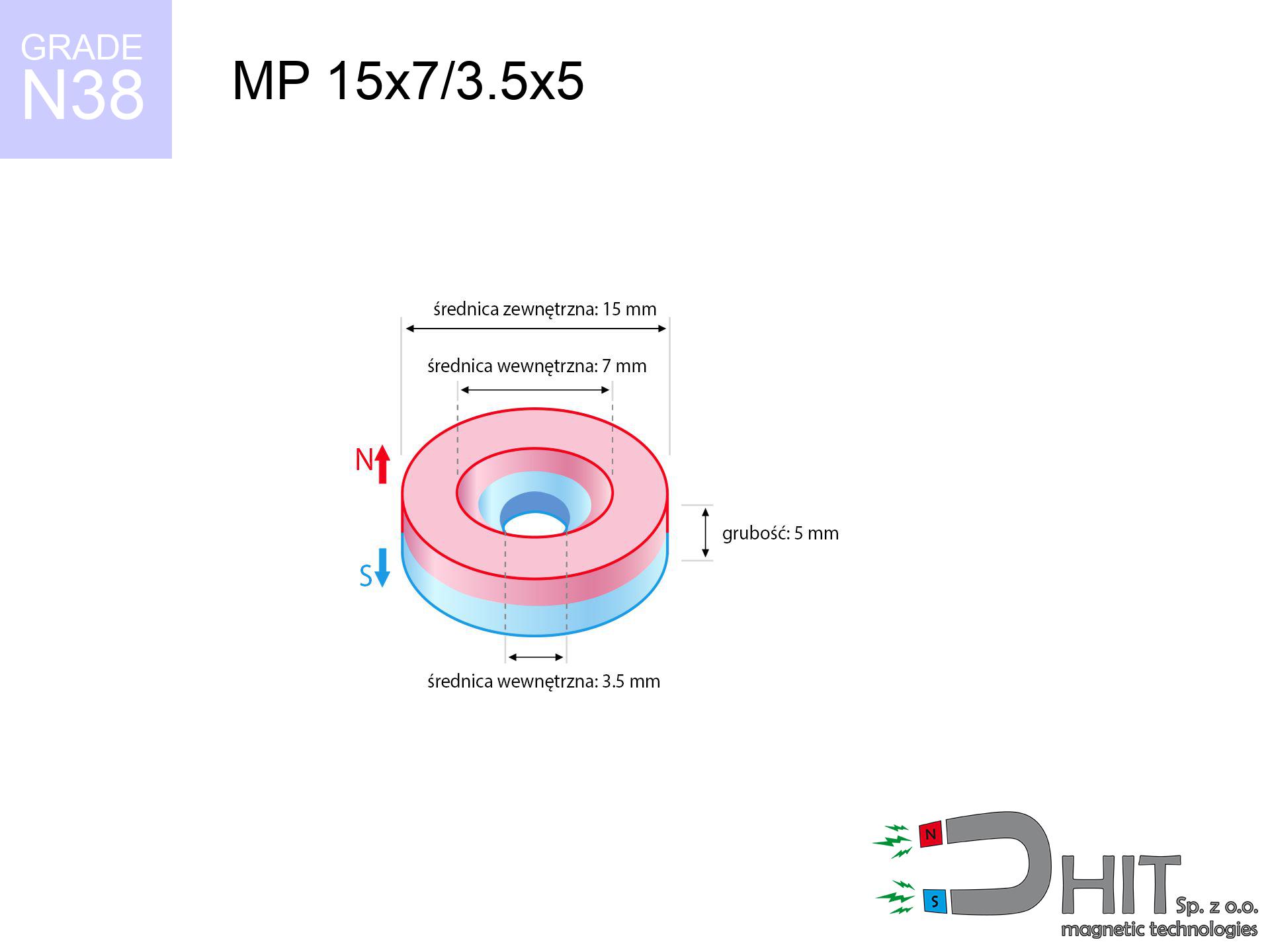MP 41x15x10 / N38 - ring magnet
ring magnet
Catalog no 030200
GTIN: 5906301812173
Diameter
41 mm [±0,1 mm]
internal diameter Ø
15 mm [±0,1 mm]
Height
10 mm [±0,1 mm]
Weight
85.77 g
Magnetization Direction
↑ axial
Load capacity
11.36 kg / 111.4 N
Magnetic Induction
223.83 mT
Coating
[NiCuNi] nickel
50.00 ZŁ with VAT / pcs + price for transport
40.65 ZŁ net + 23% VAT / pcs
bulk discounts:
Need more?Need advice?
Call us now
+48 888 99 98 98
or get in touch through
our online form
the contact section.
Lifting power along with form of a magnet can be checked using our
force calculator.
Same-day shipping for orders placed before 14:00.
MP 41x15x10 / N38 - ring magnet
Specification / characteristics MP 41x15x10 / N38 - ring magnet
| properties | values |
|---|---|
| Cat. no. | 030200 |
| GTIN | 5906301812173 |
| Production/Distribution | Dhit sp. z o.o. |
| Country of origin | Poland / China / Germany |
| Customs code | 85059029 |
| Diameter | 41 mm [±0,1 mm] |
| internal diameter Ø | 15 mm [±0,1 mm] |
| Height | 10 mm [±0,1 mm] |
| Weight | 85.77 g |
| Magnetization Direction | ↑ axial |
| Load capacity ~ ? | 11.36 kg / 111.4 N |
| Magnetic Induction ~ ? | 223.83 mT |
| Coating | [NiCuNi] nickel |
| Manufacturing Tolerance | ±0.1 mm |
Magnetic properties of material N38
| properties | values | units |
|---|---|---|
| remenance Br [Min. - Max.] ? | 12.2-12.6 | kGs |
| remenance Br [Min. - Max.] ? | 1220-1260 | T |
| coercivity bHc ? | 10.8-11.5 | kOe |
| coercivity bHc ? | 860-915 | kA/m |
| actual internal force iHc | ≥ 12 | kOe |
| actual internal force iHc | ≥ 955 | kA/m |
| energy density [Min. - Max.] ? | 36-38 | BH max MGOe |
| energy density [Min. - Max.] ? | 287-303 | BH max KJ/m |
| max. temperature ? | ≤ 80 | °C |
Physical properties of sintered neodymium magnets Nd2Fe14B at 20°C
| properties | values | units |
|---|---|---|
| Vickers hardness | ≥550 | Hv |
| Density | ≥7.4 | g/cm3 |
| Curie Temperature TC | 312 - 380 | °C |
| Curie Temperature TF | 593 - 716 | °F |
| Specific resistance | 150 | μΩ⋅Cm |
| Bending strength | 250 | Mpa |
| Compressive strength | 1000~1100 | Mpa |
| Thermal expansion parallel (∥) to orientation (M) | (3-4) x 106 | °C-1 |
| Thermal expansion perpendicular (⊥) to orientation (M) | -(1-3) x 10-6 | °C-1 |
| Young's modulus | 1.7 x 104 | kg/mm² |
Product Engineering Report
The table shows theoretical working parameters of the magnet. Real-world results may differ from the simulation.
| Distance (mm) | Induction (Gauss) / mT | Pull Force (kg) | Risk Status |
|---|---|---|---|
| 0 mm |
-2236 Gs
-223.6 mT
|
0.00 kg (0.0 g)
0.0 N
|
Safe |
| 1 mm |
-1674 Gs
-167.4 mT
|
0.00 kg (0.0 g)
0.0 N
|
Safe |
| 2 mm |
-1130 Gs
-113.0 mT
|
0.00 kg (0.0 g)
0.0 N
|
Safe |
| 5 mm |
86 Gs
8.6 mT
|
0.00 kg (0.0 g)
0.0 N
|
Safe |
| 10 mm |
766 Gs
76.6 mT
|
0.00 kg (0.0 g)
0.0 N
|
Safe |
| 15 mm |
740 Gs
74.0 mT
|
0.00 kg (0.0 g)
0.0 N
|
Safe |
| 20 mm |
580 Gs
58.0 mT
|
0.00 kg (0.0 g)
0.0 N
|
Safe |
| 30 mm |
320 Gs
32.0 mT
|
0.00 kg (0.0 g)
0.0 N
|
Safe |
| 50 mm |
110 Gs
11.0 mT
|
0.00 kg (0.0 g)
0.0 N
|
Safe |
| Surface Type | Friction Coeff. | Max Load (kg) |
|---|---|---|
| Raw Steel | µ = 0.3 |
3.35 kg (3349.1 g)
32.9 N
|
| Painted Steel (Standard) | µ = 0.2 |
2.23 kg (2232.8 g)
21.9 N
|
| Greasy/Slippery Steel | µ = 0.1 |
1.12 kg (1116.4 g)
11.0 N
|
| Magnet with Anti-slip Rubber | µ = 0.5 |
5.58 kg (5581.9 g)
54.8 N
|
| Steel Thickness (mm) | % Efficiency | Real Pull Force (kg) |
|---|---|---|
| 0.5 mm |
|
0.56 kg (558.2 g)
5.5 N
|
| 1 mm |
|
1.40 kg (1395.5 g)
13.7 N
|
| 2 mm |
|
2.79 kg (2790.9 g)
27.4 N
|
| 5 mm |
|
6.98 kg (6977.4 g)
68.4 N
|
| 10 mm |
|
11.16 kg (11163.8 g)
109.5 N
|
| Ambient Temp. (°C) | Power Loss | Remaining Pull | Status |
|---|---|---|---|
| 20 °C | 0.0% |
11.16 kg (11163.8 g)
109.5 N
|
OK |
| 40 °C | -2.2% |
10.92 kg (10918.2 g)
107.1 N
|
OK |
| 60 °C | -4.4% |
10.67 kg (10672.6 g)
104.7 N
|
OK |
| 80 °C | -6.6% |
10.43 kg (10427.0 g)
102.3 N
|
|
| 100 °C | -8.8% |
10.18 kg (10181.4 g)
99.9 N
|
|
| 120 °C | -11.0% |
9.94 kg (9935.8 g)
97.5 N
|
| Air Gap (mm) | Attraction (kg) (N-S) | Repulsion (kg) (N-N) |
|---|---|---|
| 0 mm |
0.00 kg (0.0 g)
0.0 N
|
N/A |
| 2 mm |
0.00 kg (0.0 g)
0.0 N
|
0.00 kg (0.0 g)
0.0 N
|
| 5 mm |
0.00 kg (0.0 g)
0.0 N
|
0.00 kg (0.0 g)
0.0 N
|
| 10 mm |
0.00 kg (0.0 g)
0.0 N
|
0.00 kg (0.0 g)
0.0 N
|
| 20 mm |
0.00 kg (0.0 g)
0.0 N
|
0.00 kg (0.0 g)
0.0 N
|
| 50 mm |
0.00 kg (0.0 g)
0.0 N
|
0.00 kg (0.0 g)
0.0 N
|
| Object / Device | Limit (Gauss) / mT | Safe Distance |
|---|---|---|
| Pacemaker | 5 Gs (0.5 mT) | 0.0 cm |
| Phone / Smartphone | 20 Gs (2.0 mT) | 0.0 cm |
| Credit Card | 400 Gs (40.0 mT) | 0.0 cm |
| Hard Drive (HDD) | 600 Gs (60.0 mT) | 0.0 cm |
| Start from (mm) | Speed (km/h) | Energy (J) | Predicted Effect |
|---|---|---|---|
| 10 mm |
12.32 km/h
(3.42 m/s) |
0.50 J | |
| 30 mm |
20.18 km/h
(5.61 m/s) |
1.35 J | |
| 50 mm |
25.77 km/h
(7.16 m/s) |
2.20 J | |
| 100 mm |
36.39 km/h
(10.11 m/s) |
4.38 J |
Shopping tips
Advantages as well as disadvantages of NdFeB magnets.
Besides their stability, neodymium magnets are valued for these benefits:
- They retain magnetic properties for almost ten years – the drop is just ~1% (based on simulations),
- They retain their magnetic properties even under close interference source,
- By covering with a decorative coating of gold, the element presents an elegant look,
- The surface of neodymium magnets generates a strong magnetic field – this is one of their assets,
- Through (adequate) combination of ingredients, they can achieve high thermal resistance, enabling functioning at temperatures approaching 230°C and above...
- Possibility of detailed creating as well as adjusting to concrete conditions,
- Huge importance in innovative solutions – they find application in hard drives, electric drive systems, medical devices, also multitasking production systems.
- Thanks to efficiency per cm³, small magnets offer high operating force, with minimal size,
Disadvantages of neodymium magnets:
- They are prone to damage upon heavy impacts. To avoid cracks, it is worth protecting magnets using a steel holder. Such protection not only protects the magnet but also increases its resistance to damage
- Neodymium magnets decrease their strength under the influence of heating. As soon as 80°C is exceeded, many of them start losing their power. Therefore, we recommend our special magnets marked [AH], which maintain stability even at temperatures up to 230°C
- Due to the susceptibility of magnets to corrosion in a humid environment, we suggest using waterproof magnets made of rubber, plastic or other material immune to moisture, in case of application outdoors
- Due to limitations in creating nuts and complicated shapes in magnets, we propose using casing - magnetic mechanism.
- Health risk to health – tiny shards of magnets pose a threat, when accidentally swallowed, which is particularly important in the aspect of protecting the youngest. Additionally, small components of these products are able to be problematic in diagnostics medical in case of swallowing.
- With budget limitations the cost of neodymium magnets is economically unviable,
Breakaway strength of the magnet in ideal conditions – what contributes to it?
Holding force of 11.36 kg is a theoretical maximum value performed under standard conditions:
- with the use of a yoke made of special test steel, ensuring maximum field concentration
- whose thickness reaches at least 10 mm
- with an polished touching surface
- under conditions of gap-free contact (surface-to-surface)
- under vertical force vector (90-degree angle)
- at standard ambient temperature
Lifting capacity in real conditions – factors
Effective lifting capacity is affected by working environment parameters, such as (from most important):
- Distance – the presence of foreign body (paint, dirt, gap) acts as an insulator, which lowers capacity steeply (even by 50% at 0.5 mm).
- Loading method – catalog parameter refers to pulling vertically. When slipping, the magnet exhibits much less (often approx. 20-30% of nominal force).
- Metal thickness – the thinner the sheet, the weaker the hold. Magnetic flux penetrates through instead of converting into lifting capacity.
- Material type – ideal substrate is pure iron steel. Cast iron may generate lower lifting capacity.
- Surface condition – smooth surfaces ensure maximum contact, which increases force. Uneven metal reduce efficiency.
- Temperature influence – hot environment reduces pulling force. Too high temperature can permanently demagnetize the magnet.
* Lifting capacity testing was conducted on a smooth plate of optimal thickness, under perpendicular forces, whereas under parallel forces the holding force is lower. Additionally, even a slight gap {between} the magnet’s surface and the plate lowers the load capacity.
Safe handling of neodymium magnets
Eye protection
NdFeB magnets are sintered ceramics, which means they are very brittle. Collision of two magnets will cause them cracking into small pieces.
Skin irritation risks
Certain individuals experience a sensitization to nickel, which is the typical protective layer for NdFeB magnets. Prolonged contact might lead to an allergic reaction. It is best to wear safety gloves.
Magnetic interference
Remember: rare earth magnets generate a field that interferes with sensitive sensors. Maintain a separation from your mobile, device, and navigation systems.
Implant safety
Patients with a heart stimulator must maintain an absolute distance from magnets. The magnetism can disrupt the functioning of the life-saving device.
Conscious usage
Before use, read the rules. Sudden snapping can destroy the magnet or injure your hand. Think ahead.
Dust explosion hazard
Powder created during machining of magnets is self-igniting. Avoid drilling into magnets unless you are an expert.
Maximum temperature
Regular neodymium magnets (grade N) lose magnetization when the temperature goes above 80°C. Damage is permanent.
Keep away from children
Neodymium magnets are not suitable for play. Accidental ingestion of multiple magnets can lead to them attracting across intestines, which constitutes a direct threat to life and requires urgent medical intervention.
Bodily injuries
Mind your fingers. Two large magnets will snap together immediately with a force of several hundred kilograms, crushing anything in their path. Exercise extreme caution!
Electronic hazard
Avoid bringing magnets close to a purse, computer, or screen. The magnetic field can permanently damage these devices and wipe information from cards.
Caution!
Want to know more? Check our post: Why are neodymium magnets dangerous?









